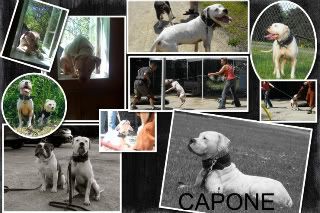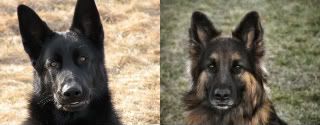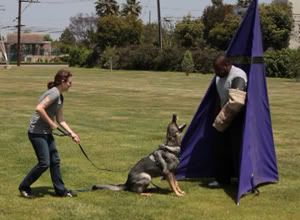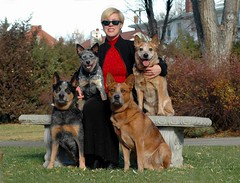 Re: Why are certain coat colors disqualified?
[Re: Mallory Kwiatkowski ]
#265736 - 02/18/2010 04:56 PM Re: Why are certain coat colors disqualified?
[Re: Mallory Kwiatkowski ]
#265736 - 02/18/2010 04:56 PM |
Webboard User

 
Reg: 12-04-2007
Posts: 2781
Loc: Upper Left hand corner, USA
 Offline Offline |
|
Well in Labs certain things are considered DQs depending on the judge like bolo spots. Bolo spots are white spots on the feet. Lab breeders tell me bolo spots are generally associated with labs of fantastic coat, but judges have it pretty clearly outlined that a white spot is permissible on the chest.
Silver (blue) has never been accepted in labs because it's a historically unheard of color which makes many suspect that it cropped up as a result of crossbreeding. I'm not sure that this is true but usually these dogs are marketed as a novelty even though akc just considers them chocolates just as they consider fox reds really dark yellow.
|
 Top Top
|
 Re: Why are certain coat colors disqualified?
[Re: Ingrid Rosenquist ]
#265737 - 02/18/2010 04:57 PM Re: Why are certain coat colors disqualified?
[Re: Ingrid Rosenquist ]
#265737 - 02/18/2010 04:57 PM |
Webboard User
 
Reg: 11-23-2007
Posts: 947
Loc: Cold-ville, Wisconsin.
 Offline Offline |
|
does that color have a name then? it looks merele to me. Then too, some times, weird ticking patterns on hounds can look merel.
Didn't mean to give incorrect info, i just put what i thought was merel coloration.
|
 Top Top
|
 Re: Why are certain coat colors disqualified?
[Re: steve strom ]
#265738 - 02/18/2010 04:59 PM Re: Why are certain coat colors disqualified?
[Re: steve strom ]
#265738 - 02/18/2010 04:59 PM |
Webboard User

   
Reg: 12-22-2006
Posts: 1824
Loc: Cambridge, MA
 Offline Offline |
|
I think it was Boxers with the coat color. White Boxers.
Excessively white ( not to be confused with albinos) individuals of any breed will have a higher incidence of unilateral or bilateral deafness than those with largely pigmented/colored coats - Danes, Dalmatians and Boxers are classic examples. I believe an absence of pigmented cells in the inner ear causes a loss of sensory hair cells... though deafness can of course also be caused by many other factors not related to coat color. 
In relation to the original question, conformation disqualifications (or poor marks) due to coat color are always in reference to the specification of the given breed standard. These standards may or may not have any historic "utility", and can be just as effected by politics as anything else. It's also good to note that breed standards can change over time, allowing or disallowing certain coloration for whatever reasons the breed club sees fit.
I can't speak to most breed standards, and each one surely has it's own complicated backstory, but as it pertains to Ridgebacks, the current color standard states acceptable colors as: light wheaton, wheaton or red wheaton - minimal white is permissible (on chest or feet), but excessive white leads to point deductions. My guess is that sandy or "grass" colored dogs blended more easily into their African bush environment, making them more effective hunters... however, MANY breeds were used in the development of the original RR standard (including the likes of ticked setters, brindled mastiffs, fawn danes, black and tan airedales, and others), and very rarely today litters will be born with random black and tan, brindle or dilute individuals (recessive genes can be carried for generations, just waiting for the right match in order for expression). Black and tan RRs are stunning dogs, but not very well liked by most fanciers and breeders because they are so very far from the written standard (as fascinating as genetic throwbacks are, they do not do anything for improving the breed {via the standard}, and are thus viewed as freak anomalies). Brindle was in fact a popular color for RRs in the very early days of the breed (20s-30s), but for reasons that have nothing to do with utility and everything to do with politics and human preference, at some point it fell from the standard.
Today, what is acceptable in the ring in the US also varies a bit from other countries as well, again due solely to preference - American breeders seem to favor lighter wheaton dogs with a little more white/"flash", where some European breeders much prefer an almost mahogany, dark red dog, and for the most part, white anywhere is highly discouraged.
This may all be more specific to a breed you have absolutely not interest in, Katie, but it's the only one I know a fair bit about! 
~Natalya
|
 Top Top
|
 Re: Why are certain coat colors disqualified?
[Re: Melissa Thom ]
#265739 - 02/18/2010 05:00 PM Re: Why are certain coat colors disqualified?
[Re: Melissa Thom ]
#265739 - 02/18/2010 05:00 PM |
Webboard User
 
Reg: 11-23-2007
Posts: 947
Loc: Cold-ville, Wisconsin.
 Offline Offline |
|
Silver (blue) has never been accepted in labs because it's a historically unheard of color which makes many suspect that it cropped up as a result of crossbreeding. I'm not sure that this is true but usually these dogs are marketed as a novelty even though akc just considers them chocolates just as they consider fox reds really dark yellow.
that is odd. Not that blue is not accepted, but that its thought to be indication of an outcross. Isn't blue just diluted black?
Theres actually a similar active topic on another forum, where someone feels that in pit bulls, ANY blue dog is the result of a cross somewhere, which is somply not true. Granted, the fad blue hippos are outcrossed, but theres solidly linebred dogs that turn up blue...Since blue is the dilute of black, if theres black in the genes, blue should be there too, just not commonly(unless you breed FOR it). or am i wrong about that too, lol.
|
 Top Top
|
 Re: Why are certain coat colors disqualified?
[Re: Natalya Zahn ]
#265741 - 02/18/2010 05:12 PM Re: Why are certain coat colors disqualified?
[Re: Natalya Zahn ]
#265741 - 02/18/2010 05:12 PM |
Webboard User
  
Reg: 08-30-2007
Posts: 3283
Loc:
 Offline Offline |
|
Ugh,
Breed standards set by some warped twisted power hungry overlord.
Ruined many a good breed.
Anyways, enre to the GSD. What I think I know goes thus;
If one thinks about it, having a white dog for herding duties would be a liability. Remember, we're not talking about a few acres of fenced pasture, we're talking whole valleys and/or mountain sides of sheep scattered hither a yon. How do you find and keep track of your dogs if they're the same color? And how much more complicated does that get when the winter snows come around?
There was a functional reason for DQing the white color.
|
 Top Top
|
 Re: Why are certain coat colors disqualified?
[Re: Mallory Kwiatkowski ]
#265742 - 02/18/2010 05:13 PM Re: Why are certain coat colors disqualified?
[Re: Mallory Kwiatkowski ]
#265742 - 02/18/2010 05:13 PM |
Webboard User

 
Reg: 12-04-2007
Posts: 2781
Loc: Upper Left hand corner, USA
 Offline Offline |
|
Silver (blue) has never been accepted in labs because it's a historically unheard of color which makes many suspect that it cropped up as a result of crossbreeding. I'm not sure that this is true but usually these dogs are marketed as a novelty even though akc just considers them chocolates just as they consider fox reds really dark yellow.
that is odd. Not that blue is not accepted, but that its thought to be indication of an outcross. Isn't blue just diluted black?
Theres actually a similar active topic on another forum, where someone feels that in pit bulls, ANY blue dog is the result of a cross somewhere, which is somply not true. Granted, the fad blue hippos are outcrossed, but theres solidly linebred dogs that turn up blue...Since blue is the dilute of black, if theres black in the genes, blue should be there too, just not commonly(unless you breed FOR it). or am i wrong about that too, lol.
I know little about dog color genetics to say what is the dilute of what but I have seen colors crop up in lines of other animals kept for decades and a 60 generations down the line. It happens. Alot of people point to the increase of popularity of chocolate as the culprit in causing this color pop up, others point to the weim, and a few others to a couple kennels who did some extreme linebreeding. Some say they have no historical proof that the color has ever been in the standard but every now and again something crops up in a litter like a brindle, a pied, a blue, a black and tan or what they are now calling charcoal. Before these puppies would be taken as a sign of a contaminated breeding and culled. Now with the dna it's a little easier to prove that these labs are descended from the indicated parents.
|
 Top Top
|
 Re: Why are certain coat colors disqualified?
[Re: Melissa Thom ]
#265744 - 02/18/2010 05:20 PM Re: Why are certain coat colors disqualified?
[Re: Melissa Thom ]
#265744 - 02/18/2010 05:20 PM |
Webboard User
  
Reg: 07-27-2009
Posts: 1421
Loc: Southern California
 Offline Offline |
|
I'm LOVING all this information! Thanks everyone, keep it coming 
|
 Top Top
|
 Re: Why are certain coat colors disqualified?
[Re: Melissa Thom ]
#265748 - 02/18/2010 05:50 PM Re: Why are certain coat colors disqualified?
[Re: Melissa Thom ]
#265748 - 02/18/2010 05:50 PM |
Webboard User

   
Reg: 12-22-2006
Posts: 1824
Loc: Cambridge, MA
 Offline Offline |
|
|
 Top Top
|
 Re: Why are certain coat colors disqualified?
[Re: Mallory Kwiatkowski ]
#265749 - 02/18/2010 06:15 PM Re: Why are certain coat colors disqualified?
[Re: Mallory Kwiatkowski ]
#265749 - 02/18/2010 06:15 PM |
Webboard User
   
Reg: 03-01-2005
Posts: 1132
Loc:
 Offline Offline |
|
does that color have a name then? it looks merele to me. Then too, some times, weird ticking patterns on hounds can look merel.
Didn't mean to give incorrect info, i just put what i thought was merel coloration.
ACDs are either red speckled or blue speckled or blue mottled. Technically there is no listing for red mottles in the standard but they not uncommon and the judges don't seem to be bothered by them. There is a move to add red mottle to the standard but I am not sure if it will ever get done. Here is a link that discusses the coloring of ACDs and shows pictorial examples:
http://kombinalong.com/home/?page_id=173
The merle gene is a very specific gene and carries with it issues such as lethal whites. As I mentioned, it is a common misconception that ACDs are merles. Probably because they are often confused with Aussies by many people.
|
 Top Top
|
 Re: Why are certain coat colors disqualified?
[Re: Ingrid Rosenquist ]
#265755 - 02/18/2010 07:22 PM Re: Why are certain coat colors disqualified?
[Re: Ingrid Rosenquist ]
#265755 - 02/18/2010 07:22 PM |
Webboard User
Reg: 06-19-2009
Posts: 27
Loc: SW Ohio
 Offline Offline |
|
Thai Ridgeback UKC Color Standard " The following solid colors are permitted: Red, black, blue and very light fawn (isabella). A black mask is preferable in red."
Here in the States blues are favored in Thailand dark red w/black mask.
|
 Top Top
|
When purchasing any product from Leerburg Enterprises, Inc. it is understood
that any and all products sold by Leerburg Enterprises, Inc. are sold in Dunn
County Wisconsin, USA. Any and all legal action taken against Leerburg Enterprises,
Inc. concerning the purchase or use of these products must take place in Dunn
County, Wisconsin. If customers do not agree with this policy they should not
purchase Leerburg Ent. Inc. products.
Dog Training is never without risk of injury. Do not use any of the products
sold by Leerburg Enterprises, Inc. without consulting a local professional.
The training methods shown in the Leerburg Ent. Inc. DVD’s are meant
to be used with a local instructor or trainer. Leerburg Enterprises, Inc. cannot
be held responsible for accidents or injuries to humans and/or animals.
Copyright 2010 Leerburg® Enterprises, Inc. All rights reserved. All photos and content on leerburg.com are part of a registered copyright owned by Leerburg Enterprise, Inc.
By accessing any information within Leerburg.com, you agree to abide by the
Leerburg.com Privacy Policy and Terms of Use.
 Previous Topic
Previous Topic Index
Index Next Topic
Next Topic













 Top
Top








.jpg)
